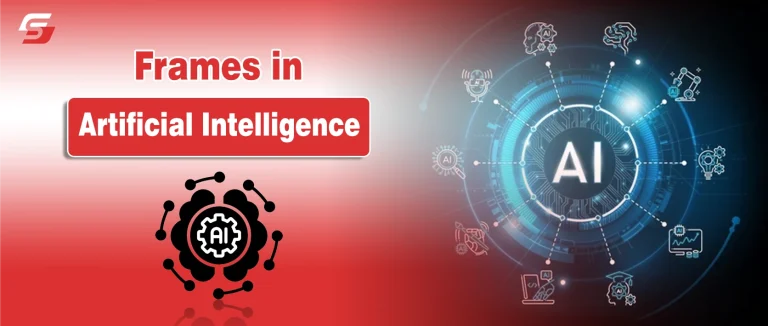Computers are smarter and perform many tasks better than humans. But here’s the catch, they don’t truly “understand” the world as we do. Storing facts is easy, but knowing how things relate, what’s typical, or what’s missing? That’s the hard part.
This is where frames in artificial intelligence become essential. They are not just data containers. They organize knowledge in a way that helps AI reason, make assumptions, and even fill gaps just like humans do. Without them, AI struggles with common-sense thinking and real-world understanding.
In this blog, you will learn how this strong method of AI representation makes AI reasoning faster and smoother.
What Are Frames in AI?

A frame in artificial intelligence acts like a template. It holds facts about an object, event, or idea. You can take it as a digital version of your mental picture. You store details, rules, and relationships in one place. Frames AI uses small chunks of knowledge that look like records. Each chunk describes something in the real world.
AI frames allow systems to answer questions fast. They work well because the structure is clear. This makes reasoning simple. You can relate one frame to another. You can build layers of meaning. That is why frames gained popularity in AI representation.
Background and evolution of frames in AI
Frames began back in the 1970s. Marvin Minsky introduced this idea. His goal was to copy human memory patterns. Humans recall knowledge through mental frames. We use these patterns to understand new information. AI developers also wanted the same method for machines.
Early systems used frames to solve real problems. They worked on language tasks and planning. Over time, new models expanded frames. Today, frames AI supports modern expert systems and reasoning tools. Even with new AI methods, frames stay useful. They still help systems organize structured knowledge.
Key Components of Frames In AI

A good frame in artificial intelligence has several core parts. These parts work together to store complex knowledge. Let’s explore the four main components.
1. Slots
The slot is the basic unit of a frame. A slot is a specific attribute. For example, a “Car” frame would have slots like “Color” and “Number of Wheels.” Every slot holds a piece of data. This data defines the object or situation.
2. Facets
Facets describe the information within a slot. They are like meta-information. They tell the system how to interpret the slot’s value. Common facets include:
- Value: The actual data stored in the slot (e.g., “red”).
- Default: A value used if no specific information is available (e.g., “four”).
- If-Needed: A procedure to calculate the value if it’s missing.
- If-Added/If-Removed: Procedures to run when the value changes.
3. Default Values
Default values are very useful. They provide a common-sense assumption. If a slot is empty, the AI uses the default. For a “Bird” frame, the “CanFly” slot might default to “True.” This saves the system time and storage. It assumes the most likely scenario.
4. Procedures
Procedures are small programs attached to a slot. We often call them demons. They activate automatically. For example, an “If-Needed” procedure runs when the AI needs a value. An “If-Added” procedure might check if a new value is valid. This allows frames to be dynamic and interactive.
Example of a Complete Frames In AI
| Element | Description |
| Parent Frame | Animal |
| Slots | Breed, Color, Sound, Size |
| Facets | Value type (text), allowed sounds (bark, growl), size range (small to large) |
| Default Values | Sound = “bark”, Size = “medium” |
| Procedures | When asked for sound → return default if none is given |
| Relations | Dog → is-a → Animal |
Introduction to Frame Inheritance
The real power of frames AI comes with inheritance AI. We don’t want to redefine “wheels” for every type of vehicle. Inheritance allows frames to share knowledge.
Key Concepts of Frame Inheritance
This process creates a knowledge hierarchy.
- Parent Frame: This is the general frame. It holds shared, common properties. For example, “Vehicle.”
- Child Frame: This is the specific frame. It inherits properties from the Parent. “Car” is a child of “Vehicle.”
- Inheritance Hierarchy: This is the tree-like structure of frames. General concepts are at the top. Specific concepts are at the bottom.
- Overriding: A child frame can change a parent’s value. The “Boat” child frame might override the “Wheels” slot to 0. Specific knowledge is always preferred.
- Extension: The child frame can add new, specific slots. A “Truck” frame would add a “Cargo Capacity” slot. The parent “Vehicle” frame doesn’t need this.
Difference between Frames and Ontologies
| Aspect | Frames | Ontologies |
| Structure | Use slots and defaults to store knowledge. | Use formal classes, relations, and logic rules. |
| Flexibility | More flexible and easy to update. | More strict and requires formal definitions. |
| Representation Style | Works like human memory models. | Follows formal semantics and description logic. |
| Reasoning | Supports quick and simple reasoning. | Supports deep, logical, and complex reasoning. |
| Best For | Practical systems that need fast access. | Large knowledge bases with strict accuracy. |
| Learning Curve | Easy to understand and design. | Harder to design due to formal rules. |
| Use Cases | Expert systems, NLP, planning tasks. | Semantic web, ontological modeling, complex domains. |
What Elements Make Up A Frame Hierarchy In AI?
A well-organized hierarchy is crucial for effective frames in artificial intelligence.
- Superframes: A superframe is another name for a parent frame. It represents the broader category. “Animal” is a superframe for “Mammal.” The superframe defines the general characteristics.
- Subframes: A subframe is another name for a child frame. It represents a more specific instance. “Dog” is a subframe of “Mammal.” It inherits all mammal properties. Then it adds unique dog properties.
- Inheritance rules: These rules govern how knowledge moves through the hierarchy. Typically, subframes automatically gain all superframe slots and default values. This rule-set ensures efficient knowledge transfer.
- Default values: Defaults are especially powerful in a hierarchy. If a specific frame lacks information, the system searches up the hierarchy. It uses the first default value it finds. This is the essence of frame AI efficiency.
Applications of Frames in AI
Frames have been used in many significant AI systems.
- Expert Systems: Frames represent complex domain knowledge. For instance, diagnosing diseases.
- Natural Language Processing (NLP): Frames capture the meaning of sentences. They hold the script or schema for an event.
- Computer Vision: Frames represent prototypical objects like a “house” or “tree.” This aids object recognition.
- Semantic Web: Frame-like structures organize and link data on the web.
How frames in AI work
The process is quite intuitive. Frames organize data for fast retrieval and reasoning.
Attributes and Relationships
Frames explicitly state attributes (slots). They also define relationships between frames. For example, the “Owner” slot in a “Car” frame points to a “Person” frame. This creates a powerful network of knowledge.
Inference and Reasoning
Frames simplify the AI representation problem. Because knowledge is structured, the AI can perform quick inferences. If the AI sees an object with “Feathers,” it quickly accesses the “Bird” frame. It then infers “CanFly” is “True” by default.
Hierarchical Organization
The hierarchy minimizes redundancy. Each property is stored once, at the highest relevant level. This saves memory. It also makes updates easier. Change a value in the superframe, and all subframes inherit the change.
Advantages of Using Frames
- Clear structure: Frames store knowledge in a neat and organized way, so systems stay simple to manage.
- Fast reasoning: AI makes quick decisions because frames reduce search time.
- Easy inheritance: Child frames reuse parent details, which saves effort and avoids repetition.
- Flexible updates: You can add or change slots without breaking the whole system.
- Human-like understanding: Frames mimic how people store facts, so they fit natural reasoning tasks.
- Modular design: You can build small pieces and connect them, which keeps large systems clean.
Challenges and Limitations
- Needs fixed structure: Frames work best with clear and stable data, not messy or changing details.
- Hard for vague knowledge: They struggle when the information is incomplete or unclear.
- Large hierarchies get complex: Big networks of frames may become hard to manage.
- Manual effort: Designers must set slots, rules, and defaults by hand, which takes time.
- Limited for dynamic tasks: Frames may not handle fast-changing real-world situations well.
Final Words
Frames offer an elegant solution to AI representation. They prove that structured knowledge is powerful. By using slots and inheritance, AI systems achieve efficient, common-sense reasoning. Frames are the conceptual bedrock for modern knowledge graphs. This classic technique remains vital for building intelligent, organized systems today.
You can even explore trending insights, like Best AI Stocks To Buy Now With Expert Tips On High Growth Opportunities.
Frequently Asked Questions
Frames are structured templates that store knowledge in slots. They help AI understand objects, events, and relationships in a clear way.
Slots hold specific attributes inside a frame. They let AI access and use information quickly.
Inheritance lets child frames reuse facts from parent frames. This reduces repetition and speeds up reasoning.
Frames offer a simple and human-like structure for organizing knowledge. This makes AI models easier to build and maintain.
Frames are flexible and intuitive, while ontologies follow strict logic rules. Frames work best for practical, quick reasoning tasks.











